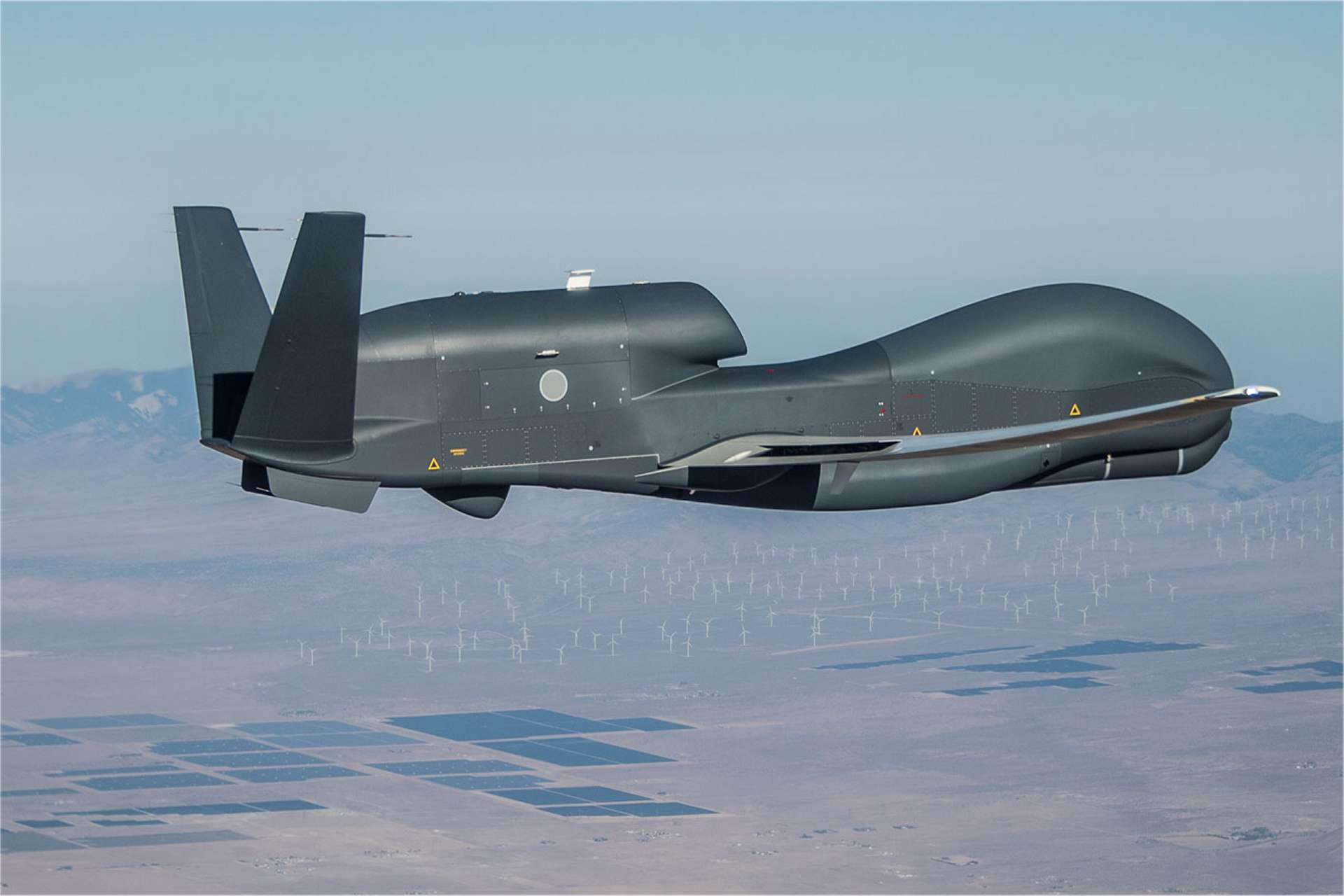US Air Force Deploys HALE RQ-4 Global Hawk Drone in the UK for the First Time

{loadposition bannertop}
{loadposition sidebarpub}
On August 22, 2024, the US Air Force took a significant step in its surveillance and reconnaissance strategy by deploying a HALE (High Altitude Long Endurance) RQ-4 Global Hawk drone to the United Kingdom for the first time. This drone was stationed at Fairford Air Base, which is already well-known for hosting the famous U-2 Dragon Lady spy planes. This deployment marks a significant moment for the US Air Force and NATO, within the framework of the Agile Combat Employment (ACE) concept, which aims to disperse and then concentrate forces to maintain air superiority when needed.Follow Army Recognition on Google News at this link
Northrop Grumman HALE (High Altitude Long Endurance) RQ-4 Global Hawk drone (Picture source: Northrop Grumman)
Before touching down on British soil, the RQ-4 Global Hawk, identified as Forte 12, carried out a complex surveillance mission across several European countries. Its flight included overflights of Greece, Bulgaria, Romania, Hungary, Slovakia, Poland, Lithuania, and Latvia. Special attention was given to Estonia and Finland, where the drone followed part of the border with Russia before continuing on to Sweden, Norway, and finally reaching Fairford Air Base.
This strategic deployment aims to enhance the US Air Force’s ability to conduct intelligence, surveillance, and reconnaissance (ISR) missions in Northern Europe, a region where airspace constraints and the complexity of transnational flights make these missions more challenging from more southern bases, such as Sigonella in Sicily. Due to these same constraints, Germany had to abandon the use of this type of drone, as it was unable to obtain the necessary certification for it to operate in its airspace.
The RQ-4 Global Hawk is a valuable asset for surveillance operations. Powered by a Rolls Royce-North American F137-RR-100 turbofan engine, it is equipped with a synthetic aperture radar (SAR), an electro-optical/infrared (EO/IR) camera, and a payload dedicated to collecting signals intelligence (SIGINT). Its exceptional endurance of 35 hours and a range of 22,000 km allow it to fly at altitudes up to 18,000 meters, with a cruising speed of 575 km/h.
However, this sophisticated drone is not without limitations, particularly regarding weather conditions and its reliance on satellite links for operation. Unlike the U-2 Dragon Lady, which can fly at higher altitudes (70,000 feet) in all weather conditions while carrying a larger payload, the Global Hawk remains dependent on external links.
On August 25, 2024, the RQ-4 Global Hawk likely carried out its first mission from Fairford, this time under the call sign Forte 16. According to FlightRadar24 data, the drone once again followed the Russo-Finnish border, reaching the Murmansk region before monitoring the area off Saint Petersburg while remaining in Finnish airspace, and then returning to Estonia to continue its mission.
This deployment to the United Kingdom underscores the growing importance of ISR operations in the context of heightened international tensions, particularly in Northern Europe, and demonstrates the US Air Force’s continued commitment to maintaining close surveillance of strategic regions.

{loadposition bannertop}
{loadposition sidebarpub}
On August 22, 2024, the US Air Force took a significant step in its surveillance and reconnaissance strategy by deploying a HALE (High Altitude Long Endurance) RQ-4 Global Hawk drone to the United Kingdom for the first time. This drone was stationed at Fairford Air Base, which is already well-known for hosting the famous U-2 Dragon Lady spy planes. This deployment marks a significant moment for the US Air Force and NATO, within the framework of the Agile Combat Employment (ACE) concept, which aims to disperse and then concentrate forces to maintain air superiority when needed.
Northrop Grumman HALE (High Altitude Long Endurance) RQ-4 Global Hawk drone (Picture source: Northrop Grumman)
Before touching down on British soil, the RQ-4 Global Hawk, identified as Forte 12, carried out a complex surveillance mission across several European countries. Its flight included overflights of Greece, Bulgaria, Romania, Hungary, Slovakia, Poland, Lithuania, and Latvia. Special attention was given to Estonia and Finland, where the drone followed part of the border with Russia before continuing on to Sweden, Norway, and finally reaching Fairford Air Base.
This strategic deployment aims to enhance the US Air Force’s ability to conduct intelligence, surveillance, and reconnaissance (ISR) missions in Northern Europe, a region where airspace constraints and the complexity of transnational flights make these missions more challenging from more southern bases, such as Sigonella in Sicily. Due to these same constraints, Germany had to abandon the use of this type of drone, as it was unable to obtain the necessary certification for it to operate in its airspace.
The RQ-4 Global Hawk is a valuable asset for surveillance operations. Powered by a Rolls Royce-North American F137-RR-100 turbofan engine, it is equipped with a synthetic aperture radar (SAR), an electro-optical/infrared (EO/IR) camera, and a payload dedicated to collecting signals intelligence (SIGINT). Its exceptional endurance of 35 hours and a range of 22,000 km allow it to fly at altitudes up to 18,000 meters, with a cruising speed of 575 km/h.
However, this sophisticated drone is not without limitations, particularly regarding weather conditions and its reliance on satellite links for operation. Unlike the U-2 Dragon Lady, which can fly at higher altitudes (70,000 feet) in all weather conditions while carrying a larger payload, the Global Hawk remains dependent on external links.
On August 25, 2024, the RQ-4 Global Hawk likely carried out its first mission from Fairford, this time under the call sign Forte 16. According to FlightRadar24 data, the drone once again followed the Russo-Finnish border, reaching the Murmansk region before monitoring the area off Saint Petersburg while remaining in Finnish airspace, and then returning to Estonia to continue its mission.
This deployment to the United Kingdom underscores the growing importance of ISR operations in the context of heightened international tensions, particularly in Northern Europe, and demonstrates the US Air Force’s continued commitment to maintaining close surveillance of strategic regions.





